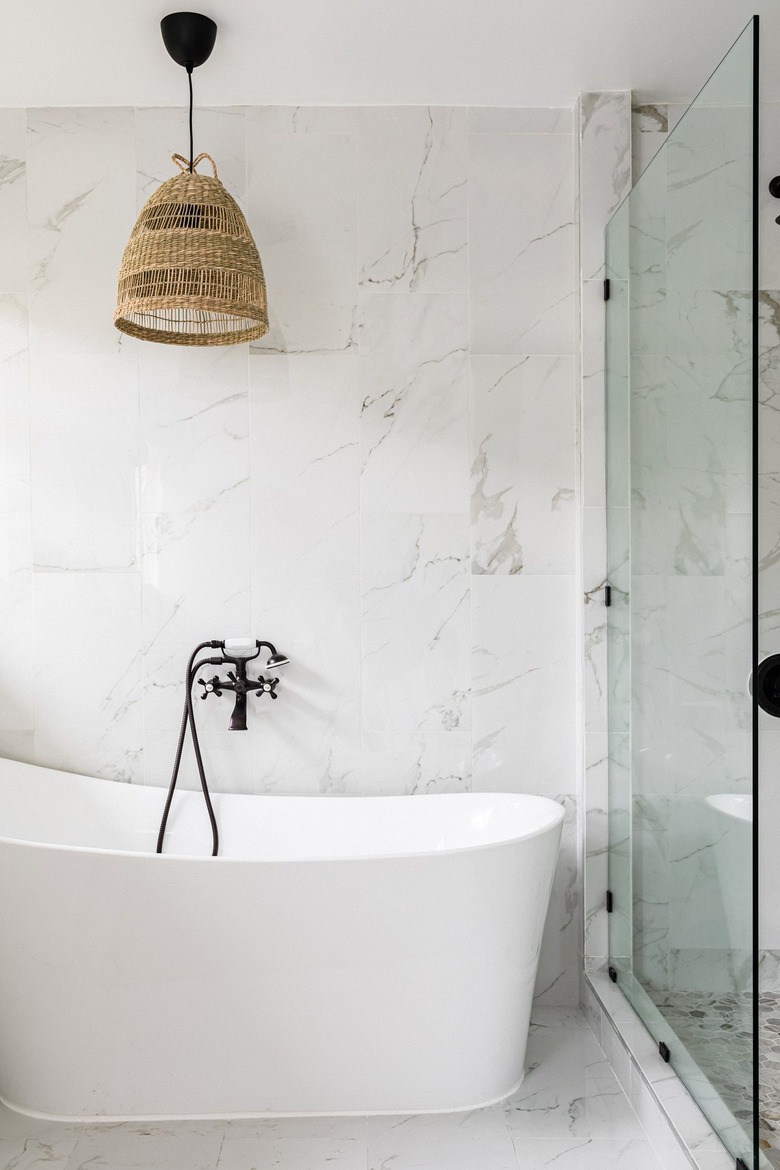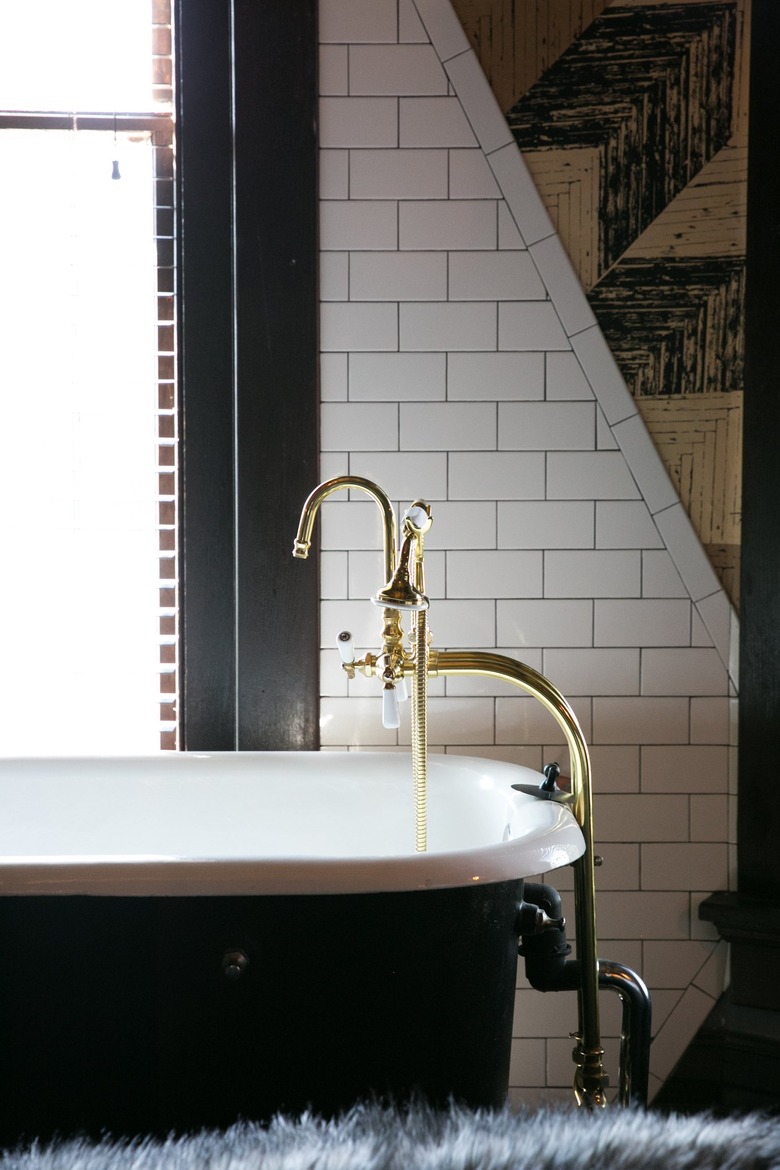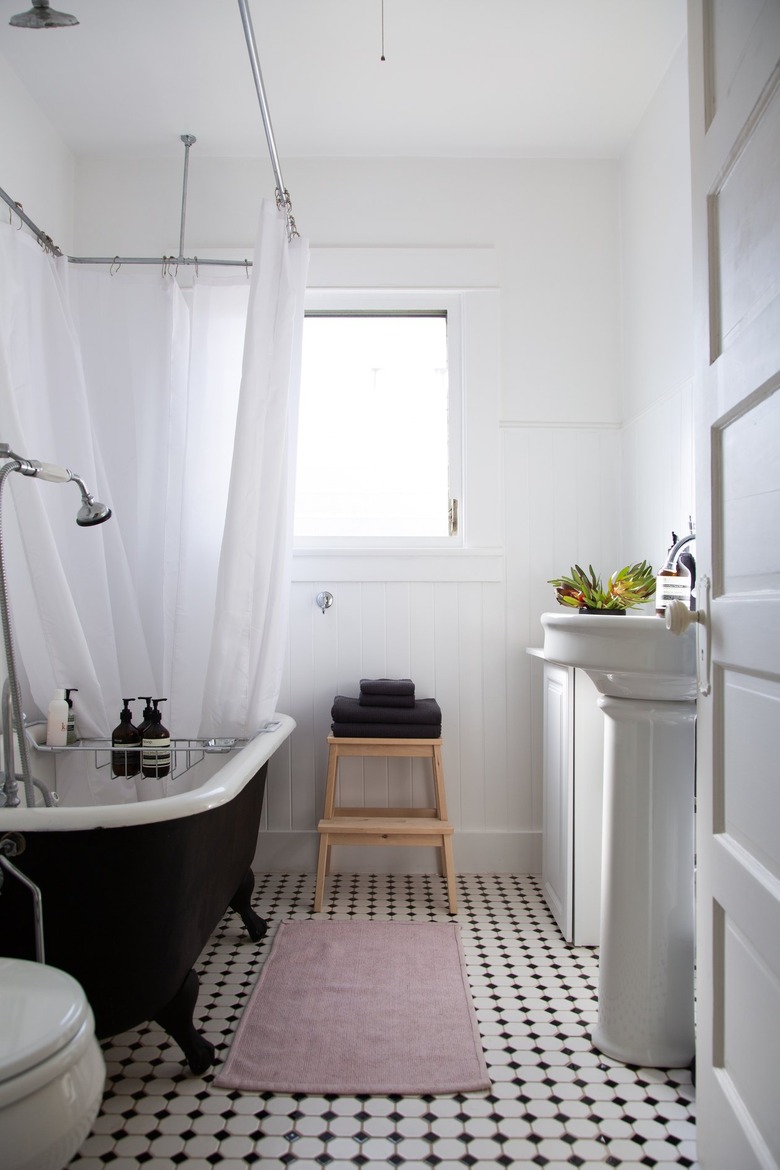Freestanding Bathtubs: What You Need To Know
If you want to make a bold statement with your bathroom remodel, a freestanding bathtub is an excellent way to do it. Elegant and sculptural, freestanding tubs quickly become the focal point of the room and easily command attention. They're also great if you like to lounge in the tub with a glass of wine after a long day. Before you start pouring the bubble bath and grabbing the corkscrew, however, make sure you've considered your new tub from every angle.
Freestanding Bathtub Basics
Freestanding Bathtub Basics
Freestanding bathtubs are those that sit on the floor of your bathroom by themselves rather than attaching to a tub surround or deck structure. You can place a freestanding tub anywhere you like in the room, but Signature Hardware suggests leaving at least 4 inches of space between the tub and the nearest wall.
If you choose a clawfoot tub or another type with an open bottom, you can add the visual illusion of more space in your bathroom even with a larger tub. You can also save space by choosing a smaller tub, such as a Japanese soaking tub. Freestanding tub choices range in size from a scant 43 inches in length all the way up to 78 inches. These long tubs are awesome if you like to stretch out and dream of a tub that will cover your knees and your chest at the same time, but you'll need plenty of space for these freestanding behemoths.
Although not attached to your wall or built in like a traditional tub, be leery of websites and salespeople who tell you that you can move a freestanding tub at any time. Technically, you can relocate a freestanding tub after it is installed, but doing so is no easy feat. Like all tubs, freestanding units require plumbing attachments that may prove to be far more difficult to move than the tub itself. Don't view a freestanding bathtub as a portable one.
Finding Your Freestanding Tub Style
Finding Your Freestanding Tub Style
Freestanding bathtubs provide a wide array of style options. One of the most basic is a single-ended tub. Single-ended tubs have a slant on one end and a faucet on the other so you can recline in the tub. You can also choose a double-ended style that slants at both ends so you can recline at either end of the tub or share the bath with someone else. On these units, the faucets are generally moved to the middle of the tub so they're out of the way.
Slipper tubs are similar to single-ended and double-ended tubs except that the end of the tub is higher than the rest of the tub. This allows bathers to lounge in the tub while staying in a more upright position. Single slipper tubs are higher only on one end, while double slippers are raised at both ends.
Of course, the widely popular clawfoot tub is also readily available, as are pedestal or skirted tubs. Pedestal and skirted tubs sit on a base that adds a bit of decorative flair. Clawfoot and pedestal tubs are available in single-ended or double-ended styles as well as single or double slippers. You can also choose a Japanese soaking tub, which is a high and round tub with a built-in seat for soaking.
Freestanding Bathtub Materials
Freestanding Bathtub Materials
Modern freestanding bathtubs are made from the same materials as their built-in cousins. Acrylic tubs are lightweight but durable and easy to clean. Solid surface materials are also widely popular. They're also easy to clean, durable and available in a matte or gloss finish. Solid surface tubs often feature built-in overflow drains that can help you hide some of the plumbing.
Classic cast iron tubs are also readily available, but keep in mind that they're quite heavy and need a very solid floor. You can also opt for a copper tub, many of which are absolutely stunning. Copper tubs are also practical, as copper is naturally resistant to both mold and bacteria. You can also get a stone tub, but these are quite heavy.
Tubs also come in stainless steel, which creates a very modern look and requires very little maintenance.
Freestanding Bathtub Pros
Freestanding Bathtub Pros
Freestanding bathtubs provide lots of benefits, not the least of which is that they are stunning. Large models can provide for much roomier lounging than most built-ins as well. They're also somewhat easier to clean than built-in bathtubs since there are none of the grooves, corners and grout lines you find on a tub surround. However, you do have to clean the entire outside of the tub as well as the exposed floor area underneath.
You also have a lot more freedom with tub placement since you don't have to keep a freestanding tub crammed up against a wall. You can even get freestanding corner tubs so you can tuck away the tub to save floor space. If soaking isn't enough for you, be aware that jetted freestanding tubs are available so you can still target sore muscles or enjoy a whirlpool bath.
Freestanding Bathtub Cons
Freestanding Bathtub Cons
There are a few drawbacks to freestanding tubs, and one is a lack of storage. Take a look at the deck of your current bathtub. If it's cluttered with shampoo bottles and the kids' bath toys, know that you'll have to find a new home for these items. You can purchase a removable tray that fits over the tub when you need these things handy, but a freestanding tub provides very little storage on its own.
And speaking of kids, remember that it can be harder to bathe kids and pets in a freestanding bathtub. Most have high sides, so bending over to bathe others may prove to be hard on your back. High sides can also make it difficult to get in and out of a freestanding tub as well. Weight is an issue too because freestanding tubs can be quite heavy by themselves, and adding water adds weight. You may need to reinforce the floor beneath a freestanding tub.
When considering a large soaking tub, think about your energy costs. According to Hudson Reed, freestanding tubs can hold up to 150 gallons of water. For a comfortable bath, you'll want about 2/3 of that water to be hot water. This can drain your hot water heater tank and your energy budget in a hurry.
Cost and Installation of Freestanding Tubs
Cost and Installation of Freestanding Tubs
Currently, the average cost of replacing a bathtub is between $1,100 and $5,900. The price range varies considerably depending on the size of the tub and the material you choose. Because they are complex to make, freestanding tubs are generally at the higher end of the range. Depending on where you want to put your tub, you may incur the additional cost of moving plumbing.
Installing freestanding tubs starts with measuring all necessary doorways and stairwells to make sure you can get a large tub into your home. You may also need to reinforce the floor where the tub will sit. When you're ready, lay the tub on its side and install the drain, setting the tub on an old blanket or rug to protect it from scratches or damage. You can then use a flexible pipe (if allowed by local code) to connect the tub drain to the floor drain or utilize a drop-in drain system. After testing the drain for leaks, move the tub into its final position.
Adjust the feet under the tub if necessary to make the tub sit flush on the floor and then use silicone caulk to secure the tub to the floor. Now all you need to do is hook up your faucet and water supply. If you're installing a freestanding, or floor-mount, faucet that will sit behind the tub or in a tight spot, you may find it easier to install it before placing the tub.
References
- Signature Hardware: Freestanding Tub Buying Guide – Best Style, Size, and Material for You
- Hudson Reed: The Ultimate Guide to Freestanding Tubs
- QualityBath.com: Freestanding Tubs: Everything You Need to Know
- HomeAdvisor: How Much Does It Cost To Replace Or Install A New Bathtub?
- YouTube: HouseBarons – How to Install a Freestanding Tub
- YouTube: TileCoach – Easy Way to Install a Freestanding Tub – Part 2


